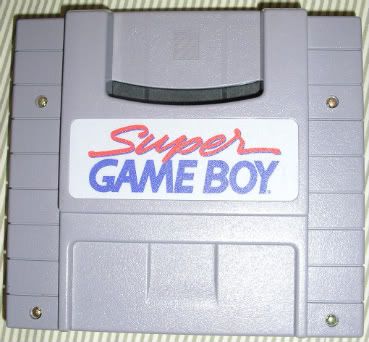
Ahh yes. Our old friend the Game Boy. With a creamy spinach color screen, A bulky feeling, and controls similar to the NES, all while boosting an impressive battery life. Developed by the late Gunpei Yokoi, it was considered Nintendo's triumph card into the handheld market.
But it wasn't the new Super MArio Land for Game Boy that got the Game Boy its mark. Oh no. It was a game developed by Russian developer Alexey Pajitnov called Tetris. How dare a game like Tetris shoot the Game Boy into popularity while the Atari Lynx, SEGA Game Gear and TurboExpress all failed due to high price, low battery life, and commercials that made Game Boy players look like red necks and non-Game Boy players look like cool kids.
Throughout the years, the Game Boy had some of the best games for the system. Games like Super Mario Land 2 and 3(Starring Wario), Zelda: Links Awakening, Mega Man: Dr Wily's Revenge, Metroid 2: Return of Samus, Final Fantasy Adventure, and even a new variation of Donkey Kong. But Nintendo wanted to give the handheld some color. The only problem is...it wasn't on its handheld, but rather on the Super Nintendo Entertainment System. The Super Game Boy.

This device hooks your Game Boy title up to the Super NES and lets you play your Game Boy titles on the screen itself. Games like Donkey Kong and Kirby's Dream Land 2 featured pre-set palettes and backgrounds. But the Game Boy was slowly, but surely, falling out. And even its competitors like the Game Gear were following out. Then Nintendo played 2 triumph cards to keep the market alive.
The first was a smaller Game Boy with a crispier screen called the Game Boy Pocket.

The second was a new franchise called Pokemon

The purpose of this game is collecting Pocket Monsters and battling others with your monster. 150 Pokemon divided between 2 games. 8 Gym Leaders, the Elite Four, Team Rocket. Pokemon became the game that revitalize the Game Boy brand. And I'm surprised the members of PETA didn't go after Nintendo for designing this game.
Alas, in 1997, Gunpei Yokoi died on October 4th 1997, killing in a car accident while trying to inspect his and another's car after a crash. The Game Boy legacy would be forever without its grandfather.
Finally, in 1998, the Game Boy finally got its Color makeover. 10 years after its debut, Game Boy evolved from the Pocket to the Game Boy Color

Compared to the original Game Boy, the Game Boy Color was short lived, but it enjoyed a sweet success with all new titles, from an update to Tetris and Zelda: Links Awakening, to Wario Land 3, Shantae, Mega Man Xtreme, and even a Game Boy Color update to the NES classic: Super Mario Bros and even 2 new Zelda games. 2 new ones. I mean seriously, 2 Zelda games? Were we not satisfied with 1 Zelda game? Did we spoil ourselves the wrong way? Oh yeah, Game Boy Color was backwards compatible with the old Game Boy lineup
But the Game Boy lineup was about to get a major upgrade. In 2001, the gaming world was introduced to the SNES-like Game Boy Advance. There were 3 variations of the GBA between 2001 and 2006.

The first variation features an advanced color screen, two shoulder buttons, a much better resolution, and backwards compatibility with Game Boy and Game Boy color games. Games on the lineup included Super Mario Advance(Super Mario Bros 2), Castlevania: Circle of the Moon, Mega Man Battle Network, Mario Kart Super Circuit, F-Zero: Maximum Velocity and Street Fighter II. SEGA even buried the hatchet and released a new Sonic game on the Game Boy Advance called Sonic Advance.
But the Game Boy Advance still had the problems of the Game Boy and Game Boy Color. Despite a sharper screen, there was no light in case one was in the dark. Furthermore, the system still relied on disposable batteries. As a result, Nintendo upped the Game Boy Advance into the SP.

The Game Boy Advance SP upgraded the Game Boy Advance from a Horizontal design to a more Clampshell design. Furthermore, it featured a backlit screen that the player can enable or disable. Finally, to address the battery problem, the GBA SP was the first Nintendo handheld to feature a rechargeable battery pack, eliminating the need to buy new batteries.
But as 2004 came to a close, the Game Boy Advance began its decline. While the Nintendo DS was suppose to be Nintendo's 3rd pillar, the DS would wind up overtaking the GBA as the successor. Adding GBA Backwards compatibility to the DS may have done more harm than good. In a last attempt to keep the Game Boy market alive, Nintendo introduced the GAme Boy Micro in 2005

The portable system was suppose to attract lesser gamers. But unlike the Game Boy Advance and Game Boy Advance SP, the Micro had no backwards compatibility with the Game Boy and Game Boy Color games. With the rising popularity of the Nintendo DS and rival system the Sony Playstation Portable, the Game Boy has died off. And the loss of the GBA Slot for the DSi was the final nail in the coffin for the Game Boy.
The Game Boy is long gone and the DS has taken over the duty of the Game Boy. But we should never forget the legacy of a system which, despite being underpowered compared to its rivals, was able to defy a generation of gamers that game on the go. And it all started with a game by Alexey Pajitnov.(IRonically, Tetris is on the DS if you wanna go check it out)
For more information, 1UP has an article on the Game Boy. You can check it out here
No comments:
Post a Comment